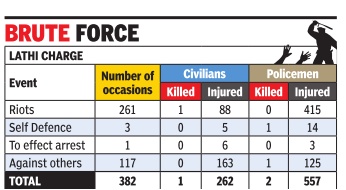Law and order operations: India
This is a collection of articles archived for the excellence of their content. |
Policemen suffer more in lathi charge

The Times of India, Aug 21 2015
Deeptiman Tiwary
During lathi-charge, it's the cops who suffer most: NCRB
More men in khaki injured than civilians
Police is routinely criticized for being baton-happy and using undue force during lathi-charge to control crowds. However, a first of its kind data released by National Crime Records Bureau (NCRB) show that whenever police have conducted a lathi-charge, it's the men in khaki who have suffered most injuries. The data show that in 2014 lathi-charge was carried on 382 occasions. In these, while 262 people got injured, the number of policemen suffering injuries stood at 557. They also led to the death of two policemen over one civilian. According to the data, most policemen got injured while trying to control a riot. Almost 75% of all policemen who got injured during lathicharge, suffered their injuries while trying to control riots. However, in the instances where police opened fire to control a mob, civilian casualties were high. In such situations 41 civilians died compared to 16 policemen. But here too injuries to policemen in such situations was higher than civilians in 2014.
According to the data, when police opened fire the ratio of police to public casualty was 1:2.5. In terms of injuries, the ratio stood at 2:1. Most civilian casualties in police firing were reported in the category of “self defence“ i.e.when police opened fire to defend itself from public ire.While controlling riots, seven people fell to police bullets.Most civilian injuries though were during riots.
Putting the matter in perspective a police officer said, “While there is no doubt that there have been instances of police using undue force on protesting public or to control riots. However, in majority of instances of lathi-charge or police firing, it's the police which first comes under attack. However, after civilians get injured, no one talks about the police, as if they are not human beings. We are just seen as the brutal arm of the state.“